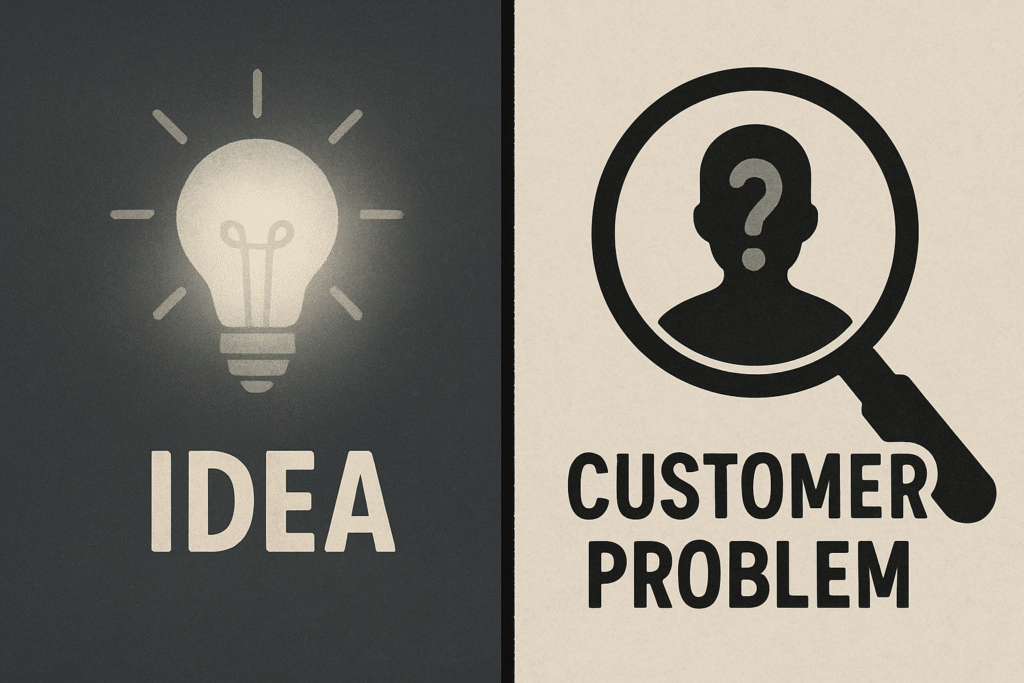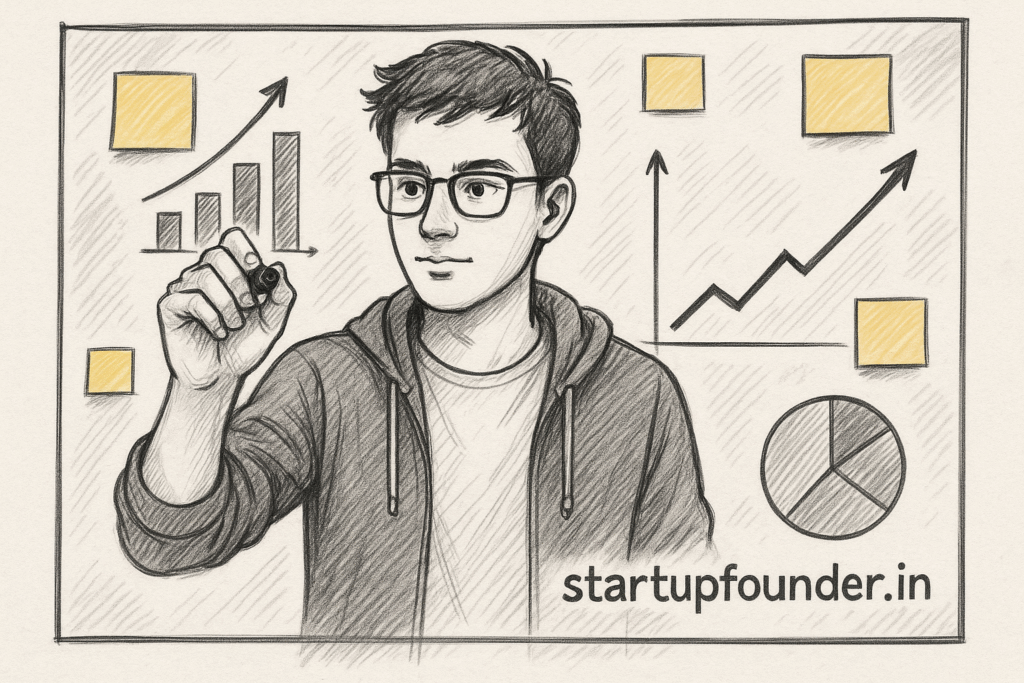A Problem-First Approach to Startup Success
Introduction: Why Most Startups Fail
The startup world thrives on energy, creativity, and the thrill of possibility. A founder often begins their journey with a spark—an exciting new app idea, a disruptive business model, or a sleek gadget that promises to change the world. Inspired by this “a-ha” moment, they dive headfirst into development, convinced that brilliance alone guarantees success.
But reality is harsher. Studies consistently show that nearly 90% of startups fail, and the single biggest reason cited—by over 40% of failed founders—is “building something no one wanted.” The cruel truth is that most startups collapse not because of poor execution, but because they never validated that a real problem existed in the first place.
This is where the Problem-First approach comes in. Instead of starting with “what to build,” it flips the script to “why to build.” By obsessively identifying, validating, and addressing genuine pain points, founders move from creating a product that is “nice to have” to building one that is “must-have.” This isn’t just a best practice—it’s a non-negotiable principle for building resilient, scalable, and valuable businesses.
In this guide, we will explore the Problem-First framework, outline actionable steps, highlight psychological pitfalls to avoid, and share case studies of companies that scaled into global giants—not because they began with a cool idea, but because they solved an undeniable problem.
Why the “Cool Idea” is a Dangerous Starting Point
Falling in love with an idea is intoxicating. Founders see elegance, novelty, and potential disruption. But what often happens next is confirmation bias—the brain selectively seeks evidence that proves the idea’s brilliance while ignoring contradictory signals. This trap leads to wasted years, burned capital, and products that launch with a thud.
The Dangers of Solution-First Thinking:
- You’re Guessing, Not Knowing: An idea is a hypothesis. Without validated problems, you’re building on assumptions, not data.
- The Problem Is the “Why”: Customers don’t pay for ideas; they pay to solve pain points. Without a compelling problem, your product lacks purpose.
- Inefficient Resource Allocation: Every dollar spent building a feature for an unvalidated idea is potential waste. Runways shrink fast, leaving startups stranded.
- Weak Marketing Narrative: If you can’t clearly explain the problem you solve, your marketing turns generic—pushing features instead of value.
A startup that begins with “what to build” risks creating an elegant solution in search of a problem. One that begins with “why to build” ensures every step is grounded in relevance.
The Problem-First Framework: A Step-by-Step Methodology
The Problem-First approach is not a one-time exercise. It’s a continuous loop of discovery, validation, and iteration. Here’s how founders can apply it systematically.
Step 1: Broad Observation and Identification of Potential Problems 🔍
The journey starts with curiosity, not creativity. Problems are everywhere, hidden in frustrations, inefficiencies, and unmet expectations.
- Listen to Complaints: Frustration is insight in disguise. Pay attention to what people complain about—poor service, outdated tools, broken workflows. These are goldmines of opportunity.
- Observe Behavior, Not Just Words: Customers often can’t articulate their needs, but their workarounds reveal the truth. If a restaurant owner uses three different tools and a notebook to manage inventory, that inefficiency signals a problem worth solving.
- Spot Market Gaps and Inefficiencies: Look at industries where monopolies dominate, technology is outdated, or customer dissatisfaction runs high. The Jobs-to-Be-Done (JTBD) framework is especially useful. Customers don’t buy products; they “hire” them to get jobs done.
- Leverage Personal Pain Points: Many successful startups originate from founders solving their own frustrations. Airbnb started with the founders renting air mattresses because they couldn’t afford rent—only later did it evolve into a global hospitality brand.
Step 2: Define the Target Audience and Problem Hypothesis 🎯
A problem without a defined audience is just noise. Once you’ve spotted a promising challenge, make it specific.
- Build Personas: Go beyond demographics. Craft a day-in-the-life profile of your customer—name, age, job, frustrations, and behaviors. This makes the abstract real.
- Formulate a Problem Hypothesis: Use a structured format—
“My target audience [specific group] struggles with [task] because of [root cause], resulting in [negative outcome].”
This forces clarity and avoids vague generalizations. - Validate Severity: Not all problems deserve a startup. Seek “hair-on-fire” issues—problems so painful that customers actively look for solutions and are willing to pay.
Step 3: Deep Customer Discovery and Problem Validation 🗣️
Here, you shift from assumption to evidence. This is where the Problem-First approach proves its value.
- Conduct Problem Interviews: The goal isn’t to pitch, but to learn. Avoid “Would you use X?” Instead ask, “Tell me about the last time you experienced [problem]. What did you do? What was frustrating about it?”
- Practice Observational Research: Watch users interact with their current tools or workarounds. Their body language and hacks often reveal pain they can’t verbalize.
- Mine Existing Data: Study competitor reviews, market reports, and customer forums. Patterns of dissatisfaction are signals of unmet demand.
- Try a “Concierge MVP”: Instead of building tech, manually perform the service. If customers pay you to solve the problem by hand, you’ve validated demand before investing in code. Zappos started this way—with its founder taking shoe photos in stores and manually fulfilling online orders.
Step 4: Transition to Solution with the Build-Measure-Learn Loop 🛠️
Only after validating the problem should you begin designing solutions.
- Build the MVP: Focus on solving the core pain point with a minimal product. Strip away features until you’re left with only the essentials.
- Measure User Response: Track engagement, repeat usage, and retention. Early adopters are your feedback loop—listen closely.
- Learn and Iterate: Pivot if assumptions prove wrong; persevere if signals are strong. Every cycle should bring you closer to a product that customers can’t live without.
Psychological Traps Founders Must Avoid
Even within a problem-first framework, founders face internal biases. Recognizing them is critical.
- Confirmation Bias: Hearing only what validates your assumptions.
- Founder Ego: Becoming too attached to your solution to adapt.
- False Positives: Misreading polite encouragement as validation. (“That’s interesting” ≠ “I’ll pay for this.”)
- Feature Addiction: Believing more features equal more value, instead of solving the problem better.
The antidote is humility—treating your startup as an experiment, not a declaration.
Case Studies in Problem-First Innovation
The most iconic startups didn’t begin with dazzling ideas; they began with validated pain points.
- Stripe: The Collison brothers were frustrated by the nightmare of integrating payment gateways. They solved for developer pain, not “payments” broadly, and built Stripe into a global platform.
- Uber: The initial problem wasn’t ridesharing—it was the frustration of hailing a cab late at night. The solution started small: an app to book premium black cars. Only later did it scale into mass ridesharing.
- Instagram: The founders realized their app “Burbn” was bloated with features. The real problem? Mobile photos looked bad and were hard to share. By focusing only on filters + sharing, Instagram became a global phenomenon.
- Slack: Born from an internal team’s communication frustrations while building a game, Slack solved the painful problem of fragmented workplace messaging.
Why Problem-First Thinking Builds Stronger Companies
Problem-First startups enjoy long-term advantages:
- Clearer Value Proposition: Customers instantly understand the “why” behind your product.
- Efficient Capital Use: Every resource is spent solving validated pain.
- Stronger Market Pull: Products solve problems people already want solved, making adoption smoother.
- Resilience in Scaling: Companies built on real problems evolve naturally with customer needs.
Conclusion: Build What Matters
In the startup journey, falling in love with ideas is easy. Building what truly matters is rare. The Problem-First approach ensures that every founder acts as a scientist—testing, validating, and iterating—rather than as a dreamer chasing assumptions.
The question is never just “What should we build?” but always “Why should we build it?”
A “cool idea” may win applause at a pitch competition. But solving a real, painful problem is what wins the market. Before writing code, raising funds, or hiring a team, start with the only foundation that lasts: the problem.
Because startups don’t succeed by being clever. They succeed by being necessary.


